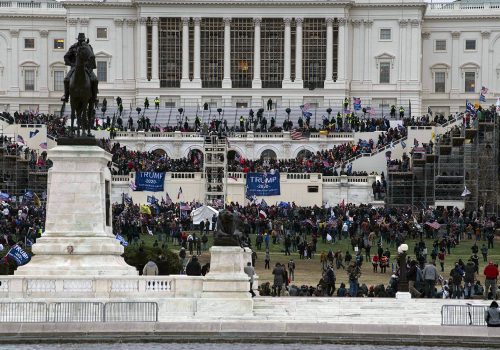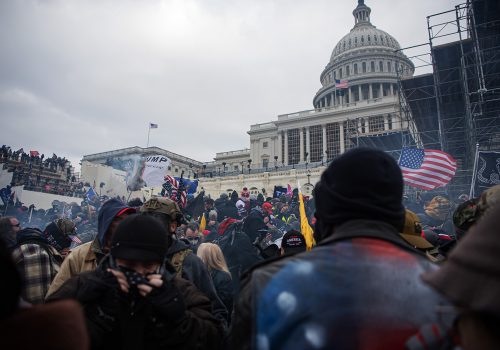FAST THINKING: How the Capitol riot was coordinated online
JUST IN
The mob that broke into the US Capitol yesterday was aided significantly by online coordination and planning. The team at the Atlantic Council’s Digital Forensic Research Lab has conducted exhaustive research into how that happened, combing through social media and other networks frequented by the far right. Let’s break down what they found.
TODAY’S EXPERT REACTION COURTESY OF
- Jared Holt (@jaredlholt): Research fellow at DFRLab
- Graham Brookie (@GrahamBrookie): Director of DFRLab
- Emerson Brooking (@etbrooking): Resident fellow in DFRLab
How it started
- Jared notes that the far-right groups that appeared at the riot maintain a vigorous online presence on “alternative” social-media platforms such as the Twitter alternative Parler, Gab, MeWe, Zello, and Telegram—“where they spread their propaganda” among sympathizers numbering “in the hundreds of thousands and even millions.” They had been publicizing yesterday’s protest on these platforms for weeks.
- The platforms have hosted escalating talk of violence since the election. And “in recent weeks, extremists repeatedly stated their desire for chaos and destruction at January 6 protests in Washington,” Jared says, adding that some previewed the tactics that were on display yesterday. “Several communities monitored by DFRLab discussed the use of overwhelming crowds to violate laws and enter the Capitol.”
- There’s another crucial aspect to how the unrest was fomented online: disinformation. The false claims Donald Trump and his allies have been pushing about the election for two months have been swirling in these same online communities. “Yesterday’s events were born out of a detachment from the shared set of facts that democracy depends on,” Graham adds.
Subscribe to Fast Thinking email alerts
Sign up to receive rapid insight in your inbox from Atlantic Council experts on global events as they unfold.

How it played out
- Thousands of people traveled from across the country to join the protest that culminated in the riot. While many were there to demonstrate peacefully, Jared notes that many others were connected with militia groups, white nationalists, and conspiracists that tend to most fully buy into Trump’s narrative that the election was stolen by dark forces bent on destroying the country. “These extremists traveled to the nation’s capital believing that it may be their last chance,” he says.
- Here’s what happened next as the protesters, after being incited by a speech Trump delivered to the crowd, marched on the Capitol and began to attack the police at its barricades: “While extremists on the ground live-streamed and bragged about the chaos they created minute-to-minute, far-right online communities aggregated their content and cheered on their efforts,” Jared says. Traffic on some far-right platforms, he adds, became so overwhelming that they began to glitch.
- Those glitches led Graham to a compelling insight: When a site like Parler or the pro-Trump forum “The Donald” broke down, “posting during the event rapidly adjusted to other platforms. The migration reiterates that the challenge of online extremism is not limited to any one platform but rather an entire, largely unregulated ecosystem with very few barriers to engage or disseminate content.”
- That’s another sign, Graham adds, that even after this turbulent transition period the underlying problems we’re witnessing are here to stay: “Unfortunately, the inevitability of the lawful transition of power won’t curb these groups, and this extreme undercurrent of America has a long history and a dangerous half-life.”
Are online crackdowns coming?
- “The beliefs driving these movements are not rational or logical, and no amount of routine debunking can deter them—especially not from outlets or sources they believe to be ‘fake news,’” Jared says. But even so, “I imagine that social-media sites where this organizing occurred are likely to come under increased scrutiny from regulators and public officials as we learn more about the platforms’ roles in the chaos.”
- Graham likewise expects increased attention from Congress directed to the smaller, “alternative” platforms where the rioters organized. “Congressional hearings we’ve seen with large social-media platforms are fast coming for smaller platforms used by extremists,” he says. “This is a cross-cutting issue that touches on homeland security, tech regulation, media standards, and many others, and it has come to a head.”
- Larger tech companies can expect continued scrutiny too. Emerson notes that both Facebook and Twitter temporarily locked Trump’s accounts last night for his incitements to violence, with Facebook saying the ban will extend at least until inauguration. “However, this action was taken only around 4 pm, after the attack on the US Capitol had already occurred,” he says. Their efforts to flag Trump’s election-related disinformation have likewise brought questionable results. “While better than nothing, this practice has limited utility,” he says. “It is of least effectiveness in fast-moving situations like the riots of January 6, in which the mere existence of Trump’s messages had the effect of pouring gasoline on a fire.”
- Emerson does see one major move coming soon. “Twitter has indicated that it will remove Trump from its service upon his next rules violation. I predict that this will happen quickly,” he says. “This would be a positive step, but long overdue.”
Further reading
Wed, Jan 6, 2021
Learning from the abyss on Capitol Hill. What now?
New Atlanticist By Frederick Kempe
The trauma should prompt us to redouble our efforts within the United States and among allies and partners to simultaneously strengthen our principles and our bonds.
Thu, Jan 7, 2021
It all depends on what happens next
New Atlanticist By Daniel Fried
A mob summoned by the US president halted democracy in America. The long-term damage to the country depends on what happens next.
Fri, Nov 6, 2020
America’s commitment to democracy must prevail at home and abroad
Elections 2020 By Daniel Fried
To pass the existential test now before us, we Americans must not only hold fast to our best values at home, but also uphold our commitment to reflecting those values as we look abroad.
Image: Pro-Trump supporters storm the United States Capitol Building after a March to Save America Rally on January 6, 2021 in Washington, DC, USA. Photo: Joel Marklund/BILDBYRÅN/Reuters


